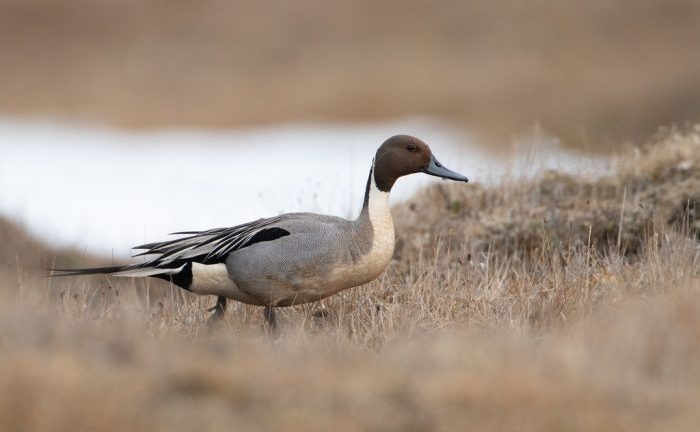Pakistan is a destination for migratory birds from all over the world. With its diverse geography and varied climatic conditions, the country provides a welcoming habitat for these winged visitors. Every year, thousands of migratory birds make their way to Pakistan, flying long distances to escape the harsh winter weather in their home countries.
In this blog post, we will explore the phenomenon of migratory birds in Pakistan, examining the different species that visit the country, their routes, and the challenges they face during their journey. From the Siberian Crane to the Amur Falcon and the Black-necked Stork, we will take a closer look at the fascinating world of migratory birds and the role they play in the ecosystem.
We will also discuss the measures being taken to protect these birds and their habitats, from conservation programs to the establishment of protected areas and bird sanctuaries. We will highlight the importance of preserving these habitats for the survival of both migratory and resident bird species.
Whether you are a bird enthusiast or simply curious about the world of migratory birds, this blog post will provide you with a deeper understanding of the fascinating journey of these winged creatures and their significance in the natural world.
List of Migratory Birds in Pakistan
- Siberian Crane
- Pallas’s Fish-eagle
- Common Teal
- Common Pochard
- Common Greenshank
- Eurasian Wigeon
- Northern Pintail
- Black-tailed Godwit
- Common Redshank
- Common Sandpiper
- Spotted Redshank
- Ruff
- Little Stint
- Dunlin
- Temminck’s Stint
Siberian Crane
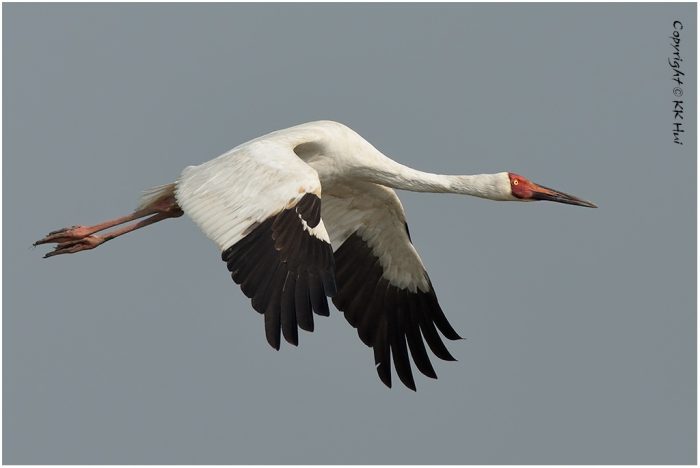
Image Source
The Siberian Crane (Leucogeranus leucogeranus) is a critically endangered migratory bird species that visit Pakistan during the winter months from November to March. They breed in the Arctic regions of Siberia and migrate towards South Asia and Southeast Asia for the winter season.
Siberian Cranes are medium-sized birds with a striking appearance. They have white plumage with black primary feathers and a long neck that is mostly black with a white crown. Their bill is long and pointed, and their legs and feet are black.
These birds are known for their long-distance migrations, which cover a distance of over 5,000 km. They fly in a V-formation, which helps them to conserve energy and navigate the long journey. In Pakistan, they can be found in wetlands, marshes, and lakes, where they feed on aquatic plants, insects, and small fish.
Unfortunately, the population of Siberian Cranes has declined drastically over the years due to habitat loss, hunting, and pollution. Conservation efforts are being made to protect their breeding grounds and stop illegal hunting. The Siberian Crane is considered a flagship species for wetland conservation and is a symbol of the need for international cooperation in wildlife conservation.
Also Read: black bird with white stripe on Wing
Pallas’s Fish-eagle
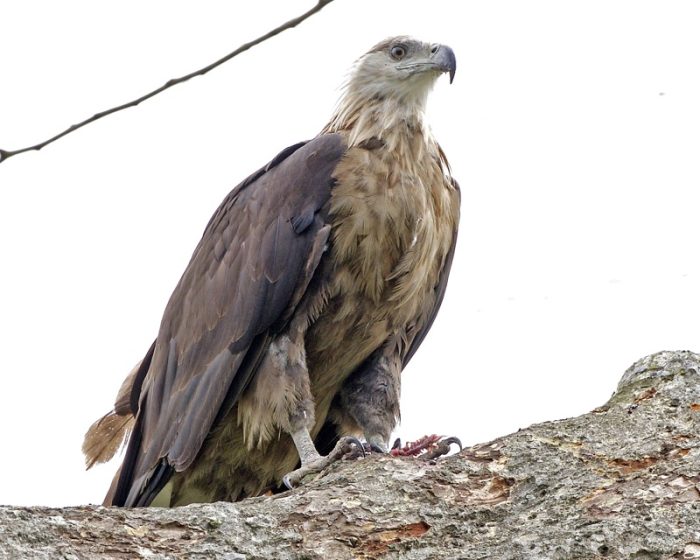
Image Source
Pallas’s Fish-eagle, also known as the Pallas Sea-eagle, is a large raptor that is found in South and Southeast Asia, including Pakistan, during its winter migration. This species breeds in Siberia, Mongolia, and China, and migrates southward to winter in Southeast Asia.
Pallas’s Fish-eagle is a large and impressive bird of prey, with a wingspan of up to 7 feet (2.1 meters) and a weight of around 9 pounds (4 kilograms). The adult birds have a distinctive white head and neck, with dark brown bodies and wings. They have sharp talons and a powerful beak, which they use to catch and eat fish, as their name suggests.
During the winter months, Pallas’s Fish-eagle can be seen in Pakistan along rivers, lakes, and other bodies of water. They are known to feed on a variety of fish species, such as carp, catfish, and mullet. They are also known to feed on other prey, including water birds and small mammals.
Pallas’s Fish-eagle is considered to be a globally threatened species, with a declining population due to habitat loss and degradation, hunting, and disturbance. Conservation efforts are underway to protect this species and its habitat, including the establishment of protected areas and conservation programs in its breeding and wintering range.
Common Teal
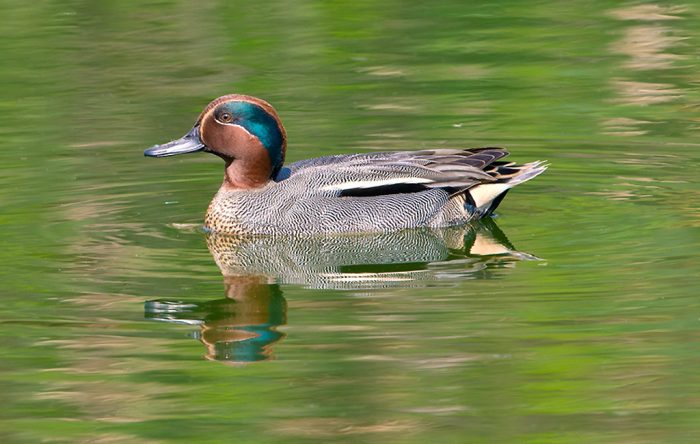
Image Source
The Common Teal, also known as the Eurasian Teal, is a small dabbling duck that breeds in the northern parts of Europe and Asia and migrates southward during winter. It is a common winter visitor to Pakistan, particularly in wetlands such as the Indus River, Manchar Lake, and Haleji Lake.
Male Common Teals have a distinctive green-colored head and a chestnut-brown patch on their flanks, while females have a mottled brown appearance. They have a pointed tail and a small bil an feed on aquatic plants, seeds, and insects, and are often seen dabbling in shallow water. They are social birds and can be found in large flocks during winter.
The Common Teal is an important game bird in many countries, including Pakistan. However, overhunting and habitat loss have led to a decline in their populations in some areas. Conservation efforts, including the protection of wetlands and hunting regulations, are crucial to ensure the survival of this migratory species.
Common Pochard
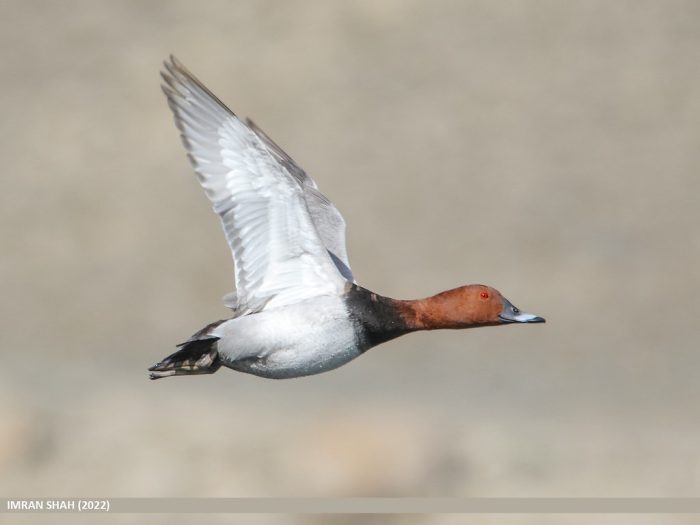
Image Source
The Common Pochard (Aythya ferina) is a medium-sized diving duck that belongs to the family Anatidae. These ducks breed in temperate regions of Europe and Asia and migrate to warmer regions during winter. They are one of the migratory birds that visit Pakistan during winter and can be spotted in wetlands and lakes throughout the country.
Male and female Common Pochards have distinctive plumages. Male birds have a chestnut-red head and neck, a black breast, and a grey back. They also have a dark tail and a black bill with a blue-grey saddle. Female birds, on the other hand, have a brown head and neck, a greyish-brown body, and a pale bluish-grey bill.
Common Pochards typically feed on aquatic plants and invertebrates such as mollusks, crustaceans, and insects. They are known to dive underwater to forage and can stay underwater for up to 20-30 seconds.
During the breeding season, Common Pochards build their nests on the ground, near water bodies. They typically lay 8-12 eggs which are incubated by the female for around 26-28 days. The young chicks are able to leave the nest and swim within a day of hatching.
The population of Common Pochards has been declining due to habitat loss and hunting, and they are now classified as a Near Threatened species by the International Union for Conservation of Nature (IUCN). Therefore, conservation efforts are needed to ensure the survival of these beautiful migratory birds.
Common Greenshank
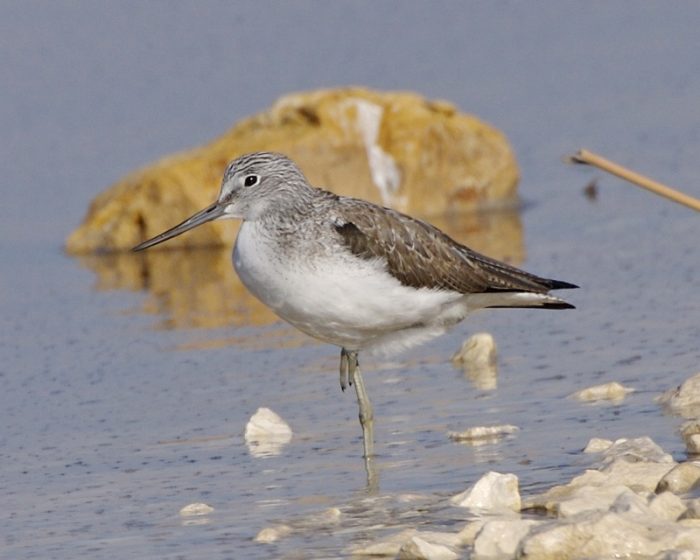
Image Source
The Common Greenshank (Tringa nebularia) is a migratory bird that visits Pakistan during the winter months. It belongs to the sandpiper family and is a medium-sized wading bird, typically measuring about 30-35 centimeters in length.
The Common Greenshank has a greyish-brown plumage with white underparts, and it has long, greenish legs. During the flight, it displays a prominent white wedge on its back and wings.
These birds prefer wetland habitats such as marshes, lagoons, and estuaries, and they are known to feed on a variety of aquatic invertebrates such as crustaceans, mollusks, and worms. They are also known to occasionally feed on small fish.
During the breeding season, which takes place in the northern parts of Europe and Asia, the male Common Greenshank performs courtship displays by flying in a zigzag pattern and calling out loudly. They build their nests on the ground close to the water’s edge and lay around 4 eggs in a clutch.
Common Greenshanks are considered a species of least concern by the International Union for Conservation of Nature (IUCN), although their population is declining due to habitat loss and degradation of wetland habitats. Pakistan has designated several wetlands as protected areas to help conserve these birds and their habitats.
Also Read: Birds with Speckeled Brest
Eurasian Wigeon
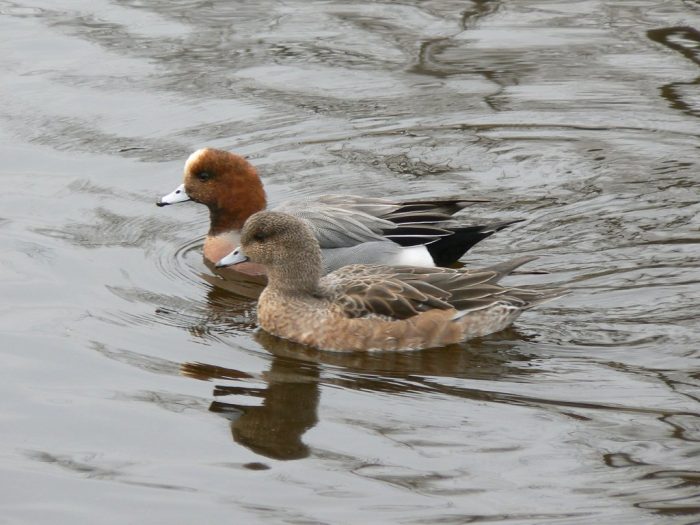
Image Source
The Eurasian Wigeon (Anas penelope) is a migratory bird that breeds in the northern areas of Europe and Asia and spends winters in the southern regions of Europe, Asia, and Africa, including Pakistan. In Pakistan, the Eurasian Wigeon can be spotted from October to March, with its peak migration period being in November and December.
The male Eurasian Wigeon has distinctive plumage, with a chestnut head, creamy-yellow forehead, and pinkish breast. It also has a pale blue patch on its wings that is visible during flight. The female is more subdued, with a mottled brown body and a dark crown.
Eurasian Wigeons prefer to inhabit freshwater wetlands, such as lakes, ponds, and marshes, where they feed on a variety of aquatic plants, grasses, and small invertebrates. During their migration, they can be seen in large flocks, often in the company of other waterfowl species.
The conservation status of the Eurasian Wigeon is considered to be of the least concern, as it has a large global population and a wide distribution range. However, habitat loss and degradation, hunting, and pollution are potential threats to this species. Conservation efforts such as the protection and restoration of wetland habitats can help ensure the continued survival of the Eurasian Wigeon and other migratory waterfowl species.
Northern Pintail
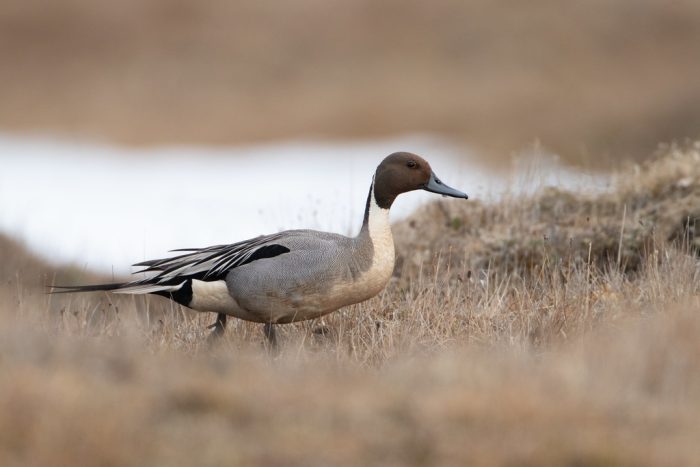
Image Source
The Northern Pintail, also known as the pintail or northern pintail duck, is a species of migratory duck that breeds in northern parts of Europe and Asia and migrates to winter in southern Europe, Africa, and parts of Asia. In Pakistan, it is a common winter visitor and passage migrant, found in wetlands, lakes, rivers, and agricultural fields.
Male pintails are easily recognizable with their long, slender necks, pointed tails, and chocolate-brown heads with a white stripe extending up the neck. They have a grayish-blue bill and a gray body with black and white stripes on their wings. Female pintails are mottled brown with a paler belly, and they lack the distinctive pointed tail of the males.
During the breeding season, pintails nest on the ground near water bodies and form monogamous pairs. The female lays 5-9 eggs and incubates them for about 22-24 days. After hatching, the ducklings leave the nest within a day and are capable of swimming and feeding themselves.
Northern Pintails feed mainly on plant material, including seeds, stems, and leaves, but they also consume invertebrates and small crustaceans. They forage by dabbling in shallow water or by grazing in fields.
The Northern Pintail is considered to be a species of least concern by the IUCN, but habitat destruction, hunting, and pollution pose threats to its population. Conservation efforts include protecting wetlands and water bodies and regulating hunting practices.
Black-tailed Godwit
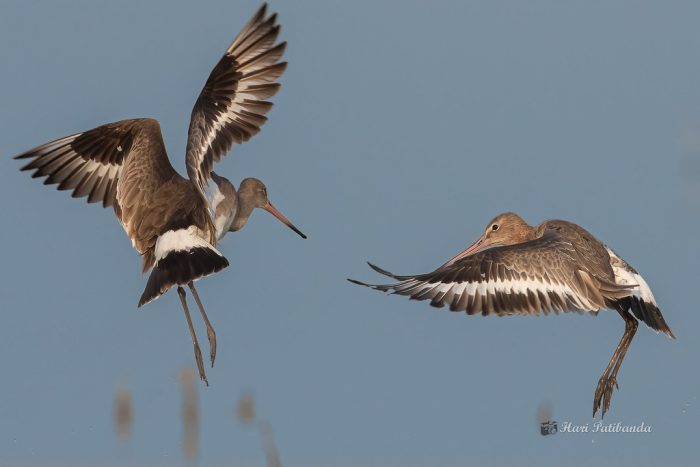
Image Source
The Black-tailed Godwit (Limosa limosa) is a migratory bird that breeds in the temperate regions of Europe and Asia and winters in Africa, southern Europe, and southern Asia, including Pakistan. The bird is known for its long, slender, and slightly curved bill, which it uses to probe the mud for invertebrates.
During the breeding season, male godwits have a bright orange-brown neck, breast, and upper parts, with a black bar across the tail and white underparts. Females have similar markings but are more subdued in color. In non-breeding plumage, both males and females have a dull grey-brown plumage with a slightly curved bill.
In Pakistan, the Black-tailed Godwit can be seen in the wetlands, marshes, and mudflats during winter migration. They are usually found in small flocks, feeding on insects, crustaceans, mollusks, and worms in shallow water. The species is known for its long-distance migrations and can cover up to 11,000 kilometers during its annual migration.
The Black-tailed Godwit is a globally threatened species and is listed as Near Threatened on the IUCN Red List. The primary threats to their population include habitat loss due to the conversion of wetlands for agriculture and urbanization, pollution, hunting, and climate change. The conservation of wetlands and the implementation of sustainable land-use practices are critical for the survival of this species.
Common Redshank
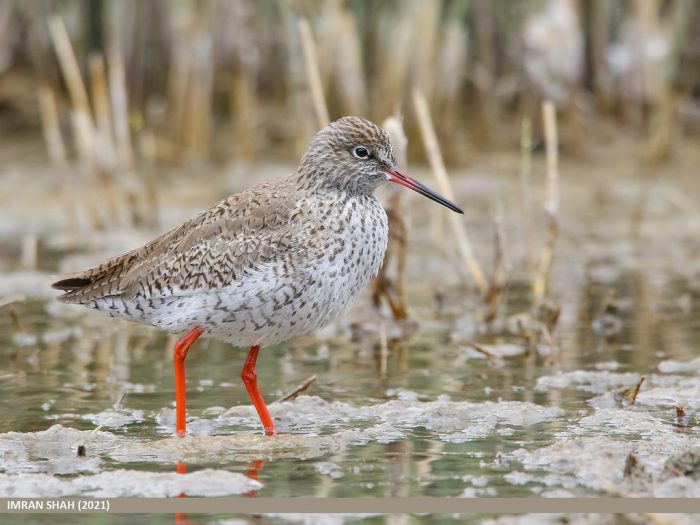
Image Source
The Common Redshank, also known as the “redshank” or “pool snipe,” is a migratory wading bird that breeds in northern and central Europe and Asia and winters in southern Europe, Africa, and southern Asia, including Pakistan. These birds are easily recognizable due to their long red legs and bill, and their bright greenish-grey wings with a white wedge visible in flight.
During the breeding season, Common Redshanks can be found in a variety of wetland habitats, including marshes, mudflats, and tundra. They feed on a variety of invertebrates, such as worms, crustaceans, and insects. They also use their long bills to probe in the mud or sand for food.
In Pakistan, Common Redshanks are primarily found along the coastal areas and wetlands during the winter months, although some may also breed in the northern regions of the country. They are often seen in large flocks, and their high-pitched “tew-tew-tew” calls can be heard from a distance. These birds play an important role in maintaining the ecological balance of their habitats by controlling the populations of their prey species.
Also Read: Black Birds with Red Heads
Common Sandpiper
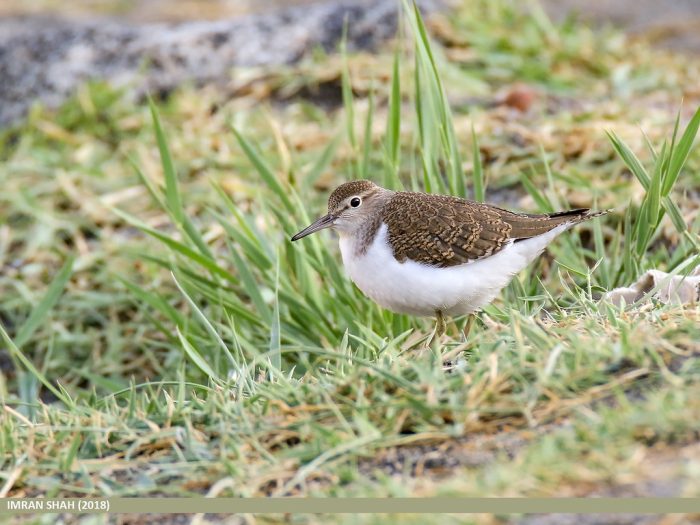
Image Source
The Common Sandpiper (Actitis hypoleucos) is a migratory wader bird that can be found in Pakistan during the winter season. It is a small-sized bird, measuring about 18-20 cm in length, with a distinctive white belly and chestnut upper parts. The bird has a relatively short bill and legs, and it often bobs its tail while foraging.
The Common Sandpiper can be found in a variety of habitats such as rivers, streams, lakes, and ponds. It feeds on insects, crustaceans, and small fish, which it hunts by walking along the water’s edge, dipping its bill into the water to catch prey.
During the breeding season, the Common Sandpiper is found in Europe and Asia, where it nests on the ground in a well-hidden location, often near water bodies. The female lays 3-5 eggs, which hatch after about three weeks. Both parents take care of the chicks, which leave the nest soon after hatching.
In Pakistan, the Common Sandpiper can be spotted in wetlands such as the Indus River Delta, Chotiari Reservoir, and Kinjhar Lake. It is a widespread bird and is not considered to be threatened. However, habitat loss and degradation due to human activities such as pollution, agriculture, and dam construction can impact the bird population.
Spotted Redshank
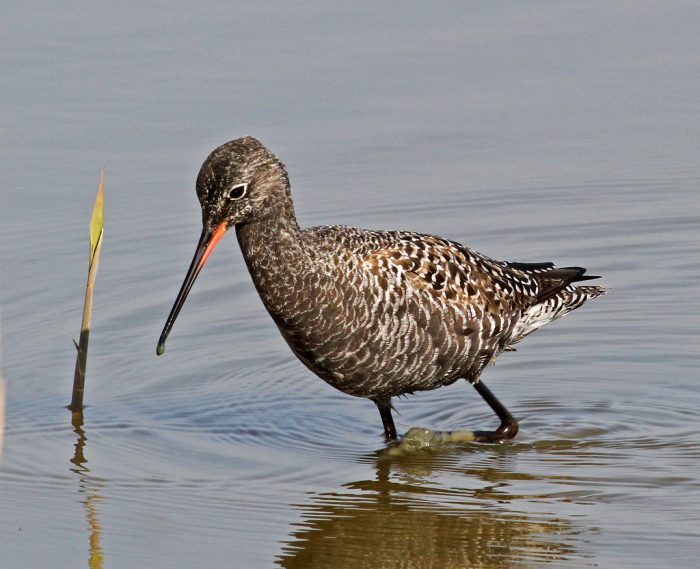
Image Source
The Spotted Redshank (Tringa erythropus) is a medium-sized wading bird that belongs to the sandpiper family. This migratory bird breeds in the Arctic region of Europe and Asia, and during the winter, it migrates to warmer regions, including Pakistan.
The Spotted Redshank is about 28-32 cm in length, with a wingspan of 60-65 cm. It has a long, straight, and slender bill that curves slightly downwards at the tip. The adult birds have dark grey-black plumage, and during the breeding season, they have red legs and a red base on the bill. The non-breeding birds have grey legs and a black bill with a red base.
During migration, the Spotted Redshank can be found in a variety of habitats, including coastal mudflats, estuaries, and freshwater marshes. They feed on a variety of invertebrates, including worms, snails, and insects.
The Spotted Redshank is not very common in Pakistan, but it can be spotted in small numbers along the coast and in certain inland wetland areas, such as Keenjhar Lake and Haleji Lake. It is a protected species in Pakistan under the Punjab Wildlife Act of 1974.
Ruff
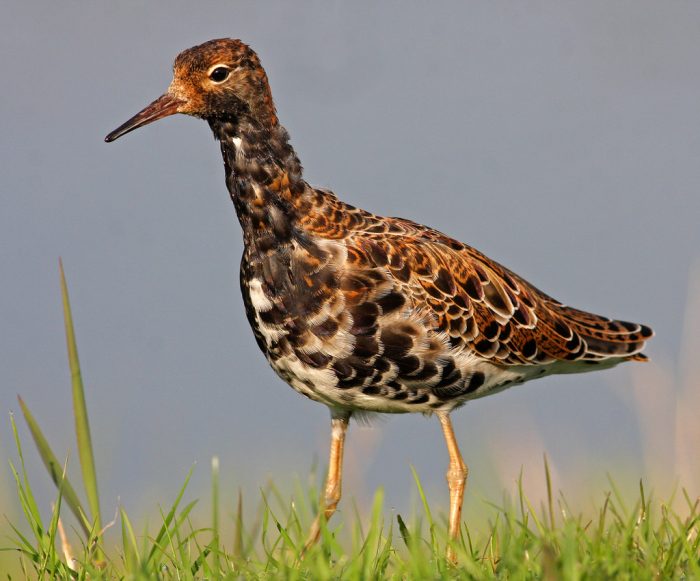
Image Source
Ruff (Calidris pugnax) is a migratory wading bird that visits Pakistan during the winter months. It belongs to the family Scolopacidae and is commonly found in wetlands, shallow lakes, and marshes. The male Ruff is larger and more brightly colored than the female, with a distinctive ruff of feathers around the neck.
During the breeding season, male Ruffs gather in groups on traditional display grounds, where they perform elaborate courtship displays to attract females. These displays involve puffing up their feathers, spreading their wings, and making various vocalizations. Once a female has chosen a male, they mate and the female lays her eggs in a nest on the ground.
In Pakistan, Ruffs can be seen in large numbers during the winter months, where they feed on insects, worms, and other small invertebrates found in the mud and shallow water of wetlands and marshes. They are an important part of the ecosystem and play a role in controlling the populations of their prey species.
However, like many migratory bird species, Ruffs are threatened by habitat loss and degradation, as well as hunting and trapping in some areas. Conservation efforts are necessary to ensure their survival and to protect their habitats in Pakistan and beyond
Little Stint
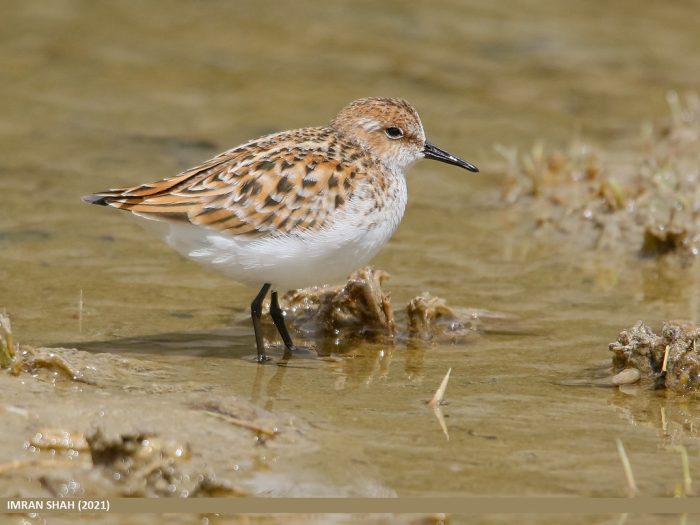
Image Source
The Little Stint (Calidris minuta) is a small migratory bird belonging to the sandpiper family, which breeds in the Arctic tundra and migrates to Asia, Africa, Europe, and Australia during the winter season. In Pakistan, Little Stints can be found in large flocks along the coast, especially in mangrove swamps and mudflats.
The Little Stint measures around 14 cm in length and has a wingspan of 28 cm. It has a distinctive pattern of dark and light feathers on its upper parts, with a reddish-brown head, neck, and breast, and a white belly. During the breeding season, males have brighter plumage than females.
Little Stints are primarily insectivorous, feeding on a variety of insects, crustaceans, and other small invertebrates. They forage on the mudflats and shallow waters of estuaries and coastal lagoons, using their long, thin bill to probe the soft sediment for prey.
During the breeding season, Little Stints form monogamous pairs and build a ground nest in the Arctic tundra, usually near water. The female lays 3-5 eggs, which are incubated for around three weeks by both parents. The chicks are precocial, meaning that they are able to move and feed themselves shortly after hatching.
The Little Stint is considered a species of least concern by the International Union for Conservation of Nature (IUCN), with a stable population trend. However, habitat loss and disturbance of their breeding grounds due to climate change and human activities may pose a threat to their long-term survival.
Dunlin
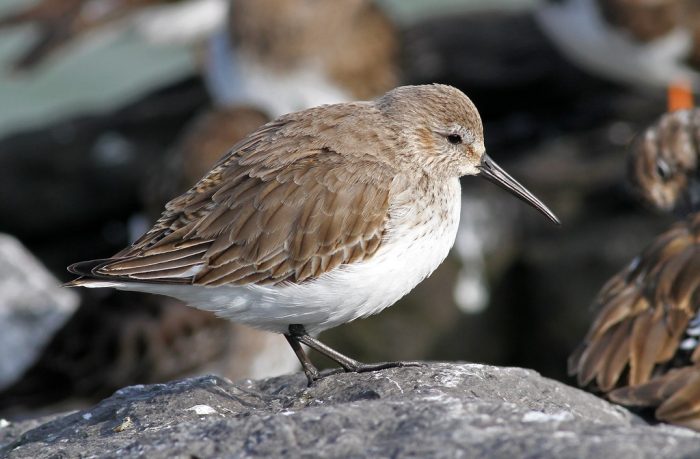
Image Source
Dunlin (Calidris alpina) is a migratory bird species that can be found in Pakistan during winter. They belong to the sandpiper family and are one of the most common shorebirds seen in the world. They are also known as the red-backed sandpiper or the little stint, due to their small size and reddish-brown feathers on their back during the breeding season.
Dunlins have a distinctive long, slightly curved bill, which they use to probe the mudflats and sandy beaches for invertebrates like crustaceans, mollusks, and worms. During winter, they form large flocks and can be seen foraging along the coastlines or mudflats, often in the company of other shorebird species.
In breeding season, Dunlins migrate to the Arctic tundra and build their nests on the ground. They lay 3-4 eggs, which hatch after about 20 days of incubation. The chicks leave the nest within a few hours of hatching and are able to feed themselves within a few days.
The population of Dunlins has been declining due to habitat loss and degradation, as well as hunting in some areas. In Pakistan, they are protected under the Wildlife Protection Act of 1972, and their hunting is prohibited. Conservation efforts are needed to protect their breeding and wintering habitats, as well as to raise awareness about their importance in the ecosystem.
Temminck’s Stint
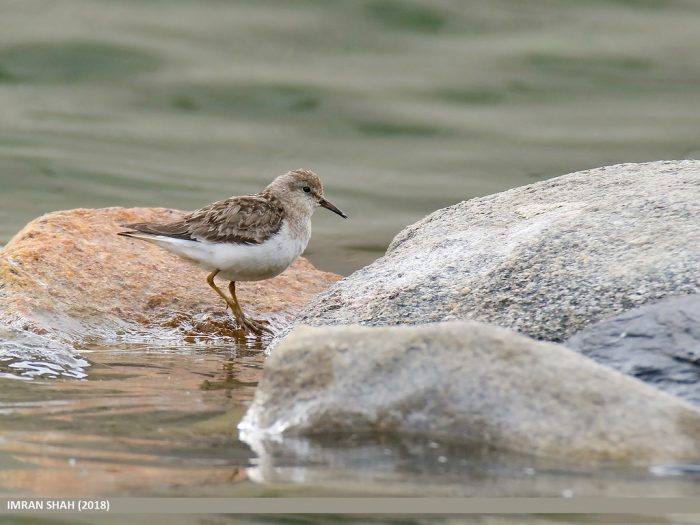
Image Source
Temminck’s Stint is a small migratory wading bird that breeds in the Arctic tundra and winters in sub-Saharan Africa, the Indian subcontinent, and Southeast Asia. In Pakistan, it can be spotted during the winter months in wetlands, marshes, and flooded fields.
The Temminck’s Stint measures about 14 cm in length and has a wingspan of approximately 29 cm. The male and female have similar plumage, with a distinctive white V-shaped patch on the back and a pale eyebrow stripe. During the breeding season, the male’s upper parts are dark brown, while the female has more uniform brownish-grey plumage.
Temminck’s Stint feeds on small invertebrates, such as insects and their larvae, crustaceans, and mollusks, which it picks from the water’s surface or probes from mud with its bill. It is a solitary bird, often seen alone or in small flocks, and is known for its quick movements and rapid wing beats.
The breeding season of the Temminck’s Stint begins in late May to early June, with the birds arriving at their breeding grounds in the Arctic tundra. The nest is a shallow scrape in the ground, often lined with vegetation and feathers. The female typically lays 4 eggs, which are incubated by both parents for about 18-19 days. The chicks are precocial, able to leave the nest shortly after hatching, and are cared for by both parents until they fledge at around 18-21 days old.
Also Read:
- Birds with Red Breast
- Species of Birds in Pakistan
- Birds with orange chest
- Pink Birds
- Blue bird symbolism
- Gray birds with white bellies
- Doves in Oklahoma
- Best talking birds
- Sparrows with stripped heads
FAQs on migratory birds in Pakistan:
What are migratory birds?
Migratory birds are those species of birds that travel long distances every year from one habitat to another.
Which migratory birds can be found in Pakistan?
Pakistan is located on the migratory route of several bird species. Some of the most commonly seen migratory birds in Pakistan include Siberian Crane, Demoiselle Crane, Eurasian Wigeon, Northern Pintail, Common Teal, Ruddy Shelduck, and Black Stork.
When do migratory birds arrive in Pakistan?
Migratory birds usually arrive in Pakistan in winter, between the months of October and March. However, the timing of their arrival can vary depending on the species and their migration routes.
Where can I spot migratory birds in Pakistan?
Pakistan is home to several wetlands and bird sanctuaries that serve as important habitats for migratory birds. Some of the popular places to spot migratory birds in Pakistan include the Wetlands Reserve in the Indus Delta, Keenjhar Lake, Hingol National Park, and Manchar Lake.
What threats do migratory birds face in Pakistan?
Migratory birds face several threats in Pakistan, including habitat loss due to development and human activities, hunting, poaching, and pollution. Conservation efforts are necessary to protect these birds and their habitats.

